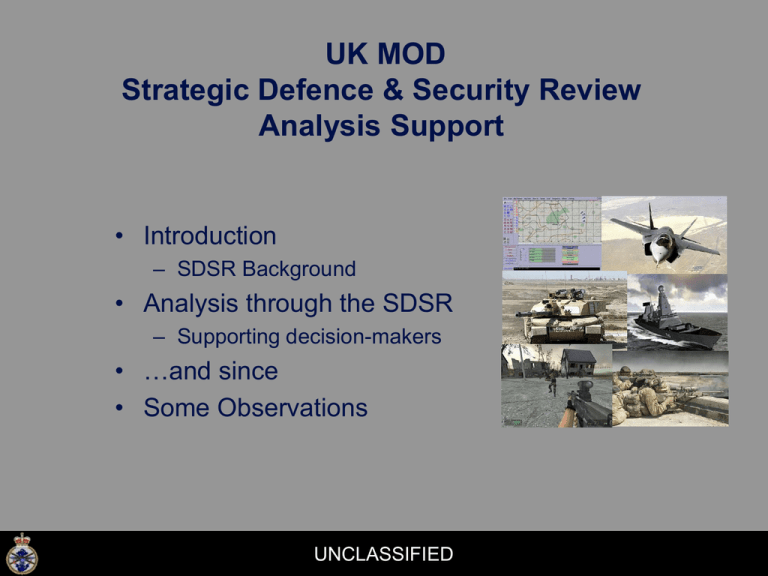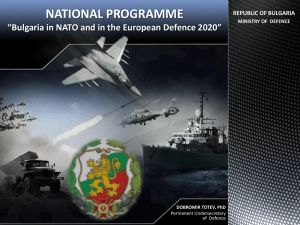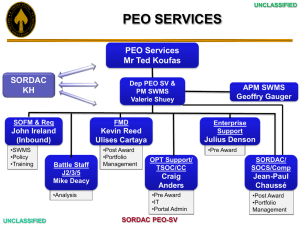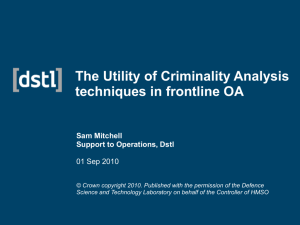the presentation
advertisement

UK MOD Strategic Defence & Security Review Analysis Support • Introduction – SDSR Background • Analysis through the SDSR – Supporting decision-makers • …and since • Some Observations UNCLASSIFIED National Security Strategy Strategic Defence and Security Review (SDSR) UNCLASSIFIED National Security Strategy • • • • Strategic Context Britain’s Distinctive Role National Security Risk Assessment National Security Tasks & Planning Guidelines • Adaptable Britain – – – – – – Respond to highest priority risks Respond to low probability but very high impact risks Focus on upstream activity Retain a broad spectrum of security and defence capabilities Strengthen relationships with key allies Coordinate and integrate whole of Government response UNCLASSIFIED But it’s the economy, stupid....... £45 6% Expenditure £Bn on Defence £40 £34Bn average 5% £35 Defence costs in excess of inflation erode buying power 4% £25 3% £20 Falklands conflict % of Defence spend as proportion of GDP £15 2% £10 1% £5 Iraq conflict £0 1970/71 1975/76 1980/81 1985/86 1990/91 1995/96 2000/01 Years • UK Personnel Costs – Average 1.7% above inflation per annum • UK Equipment & Support costs – 3-5% above inflation per annum UNCLASSIFIED 2005/06 0% 2009/10 % GDP The spend, in real terms has remained constant. £ Billions £30 Outcomes - SDSR Themes • • • • • • Uncertainty: adaptability; readiness Future Conflict: intelligence; precision; mobility Independence: UK; Overseas Territories Multilateralism: risk management Combat Focused: reductions in non-front line areas Affordability UNCLASSIFIED Defence Head Office structure UNCLASSIFIED 18-20 Oct 2010 Overview of analytical support to SDSR CSR Spending Review Advice on cyber & horizon scanning NSS National Security Strategy Work strands Implementation Learn lessons to improve support to future SDSRs Synthesis (DSG and NSC) Ideas Advice and analysis to support 18 of 41 work Maystrands June Policy Choices Synthesising work strand ideas. Force structure risk assessment July August Capability Choices SDSR Highlight, and help mitigate, risks of PR11 options SDSR Headlines Workshops with S&T stakeholders to shape strategy PR11 Detail Defence Industry & Technology Policy Green Paper White Paper Defence Reform Review Defence Acquisition Reform Programme Sept Oct Nov Dec Jan Technical advice and alignment with Dstl and S&T strategies UNCLASSIFIED Apr 2011 Sep 2011 Cost Analysis aided the understanding of the scale of the financial savings • Negotiations with Treasury reduced savings target from 10-20% to 7.5% – Cost analysis helped explain to VCDS, Strategy and Finance staff why MoD’s plans needed to reduce by 25-40% to achieve savings of 10-20% UNCLASSIFIED Cost Analysis aided the understanding of the scale of the financial savings • Negotiations with Treasury reduced savings target from 10-20% to 7.5% – Cost analysis helped explain to VCDS, Strategy and Finance staff why MoD’s plans needed to reduce by 25-40% to achieve savings of 10-20% UNCLASSIFIED Developing the Defence Response Matching Resource to Aspiration Increasing Levels of Ambition Homeland Influence Intervention Stabilisation Policy Choices Prioritise Capabilities and shape the force structure to achieve affordability UNCLASSIFIED Analysis Tools aided the understanding of the relationship between Planning Assumptions, Costs and Force Structure UNCLASSIFIED Force Structure Cost - Projected defence budget in 2020 Force Structure Cost Visualisation Tool Defence Planning Assumptions (DPAs) Cost Pressures 80 Reset all DPAs Annual Compounded Standing Commitments Steady State 2 Equipment Procurement (Aerospace) R 0.0% 0% 60 # Equipment Procurement (Other) COO1 1 None Small Scale 0.0% 0% 1 R Non-Enduring Equipment (Running Cost) Enduring Medium Scale 0.0% Cost R 40 0% R COO2 1 1 None Non-Enduring Small Scale Enduring Personnel 0.0% 0% 20 R Other Medium Scale 0.0% 0% R COO3 1 None Small Scale Medium Scale 1 0 now Overheads 0 0 0 0 future Non-Enduring Enduring Overhead Deflator Annual Compounded 0.0% 0% 100 R Graph Update Graph Harmony 2 1 in x 1 in y TRUE DPA data is available. Overheads COO Standing Commitments Flat Real Flat Cash -14% Graph Legend Order Auto-update Available? Top Herrick R 3rd Standing Commitments Standing Commitments 1 2nd COO COO 3 Overheads Overheads 1 Base UNCLASSIFIED 31 Tables High Level Summary Strategy Management Analysis helped inform the development of Defence Planning Assumptions • The Armed Forces in the future will be sized and shaped to conduct Standing Commitments plus: – an enduring stabilisation operation – one non-enduring complex intervention – one non-enduring simple intervention Chosen by National Security Council from 3 affordable postures developed using Dstl FaST tool UNCLASSIFIED Set at 2 interventions after analysis showed that 3 were unaffordable and unlikely historically Analysis Supported the development of Future Force 2020 UNCLASSIFIED Analysis Supported the development of Future Force 2020 • Developed initially by DG Strategy, drawing upon Dstl analysis – Scenario-based analysis generated insights into force requirements – Force structure analysis highlighted differences between ‘ideal’ DPA force structure and 2015 post-Afghanistan force – Synthesis of workstrand paper ideas • Identified 5 key questions that drive the shape of the force • Generated three coherent force structures for 10% and 20% savings levels • Highlighted constraints and dependencies between policy aspirations and capability • Tested forces emerging from Senior Decision Maker discussions – Informed VCDS Senior Judgement Panel debates on the value of major force elements • Capability analysis informed the understanding of risk within and across the Defence Planning Assumptions UNCLASSIFIED Output Evolution Understanding new Policy by Capability Area Dynamic Demonstrator By area with specific investigations Optimised Force Structures Changes to Policy Shortfalls & Affluences in Force Structure 2010 Cost Effectiveness of Force Elements Impact of PR11 Measures Impact of possible Policy Choices Capability Audit Risks 2015 Post SDSR Capability Packages 2020 RISK 1 RISK 2 RISK 3 Impact of PR11 SDSR Measures Epoch 1 A B C D E F G H I J K L M N O Risk in FF20 Risks in for a given Force Structure against a given Policy Investigation into specific areas for IAB submissions, e.g. JCA, SCAVENGER, AH • Increasing number of levels of information – • Increasing range of tailored communication methods – • Including; handouts, interactive briefings, supported desk level discussions, memos Increasing amount of interaction – • From Whole Force Structure, Capability Packages / Areas, down to Force Elements From set handout or brief to interactive briefs holding a depth of information as required Increasing combinations of outputs – Optimisation and risk picture, joint outputs with other specific studies (e.g. Joint Fires) UNCLASSIFIED Post SDSR with PR11 Measures Epoch 2 Epoch 1 Epoch 2 Whew! UNCLASSIFIED But....the world moves on... • Funny old thing... – – – – – Some residual variance on the programme Reality of reaping all of the predicted savings Overall size and shape of the Army post Afg New CDM (Bernard Grey) cost realism FOREX/Fuel The “3 Month Exercise” – – – – Equipment Affordability Reserves Review Basing study Implications of ‘Arab Spring’ UNCLASSIFIED Analysis in support of the 3 Month Exercise • MoD needed to better understand the requirement to re-balance the books – Responsive Cost Analysis • Further Senior Judgement Panels recommended areas where reductions could and couldn't be taken – Dstl provided 8 perspectives on Force Structure & Capability – Costs, risks against Defence Planning Assumptions, and implications in terms of historic operations context • SofS announcement 18th July 2011 UNCLASSIFIED Some Analysis Observations... • The challenge of ‘real decision-support’ vs ‘doing studies’ – The use of analysis is not a given – Has to prove itself useful and credible – Timely and accessible • Value of ‘deployed analysts’ • Foundation of the evidence base and tools – Force Structure Cost Model – Force Structure analysis tools – Strategic Balance of Investment & capability analysis • Value of visualisation techniques & responsive tools • Flexibility, responsiveness and determination UNCLASSIFIED Questions? UNCLASSIFIED








